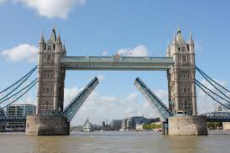
Tower Bridge is probably the UK’s most famous bridge. It’s a work of Victorian art: it was built between 1886 and 1894, but the bright blue railings were only painted that colour in the 1970s, as it was to celebrate Queen Elizabeth II’s silver jubilee. The central part of the bridge road lifts up to allow big boats to cross under it, whilst the bridge is built in a suspension bridge style. Suspension bridges were pretty popular in Victorian times, especially after Brunel constructed the Clifton Suspension Bridge near Bristol.
The Bridge was built because a new Thames crossing was needed in the East End of London. There was a lot of growth in business in the area, so the infrastructure would naturally have to be improved. Road traffic was getting a lot bigger, and whilst the Bridge would ease this, it would reduce access to the Pool of London. The solution was to create a lifting bridge. It cost around £120 million in today’s money to build, and it was opened in June 1894 by the Prince of Wales.
The two walkways near the top of Tower Bridge had got a bad reputation when the Bridge first opened, because they were known for pickpockets and other criminals. These walkways were closed in 1910 because nobody ever used them. Nowadays, though, they are part of the Tower Bridge exhibition. For a fee, you can walk across these two walkways, have a look inside the two towers themselves, and see the old Engine rooms which used to power the lifting bridge. They also had quite a big role in the 2012 Olympics and Paralympics, especially during the Opening Ceremony. Planes flew through the centre of the bridge, and David Beckham went under it on a boat!
Recently, a glass walkway has been opened along the top two walkways. It allows visitors to see right down to the road and the Thames below them. Recently, though, one of the glass panes cracked in one of the walkways. Nobody was in any danger, as there was another level of safety glass beneath it. Still, it cost money to repair, and part of the exhibition had to be closed off as a result.
The bridge is free to walk across, and you can watch it being lifted from the banks of the Thames. However, if you want to go to the exhibition, it’s £4 for a child ticket and £6.50 for a student ticket. The closest stations are London Bridge on the South Bank, and Tower Hill on the North side of the river. It can also be accessed by DLR if you get off at Tower Gateway, and of course there are many tourist buses (and local London buses) that drive across the bridge. It’s a very pleasant walk down the river to Tower Bridge, and you’ll pass lots of shops, restaurants and pubs where weary travellers like yourself can refuel and prepare for the rest of the day. As the Tower of London is just at the end of the Bridge, why not pay a visit there?
Image from: http://scienceenglishschool5th.blogspot.com/

0 Comment:
Be the first one to comment on this article.